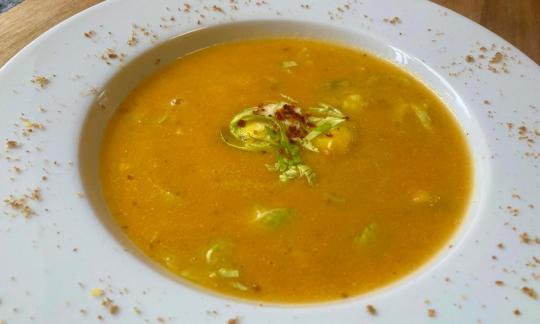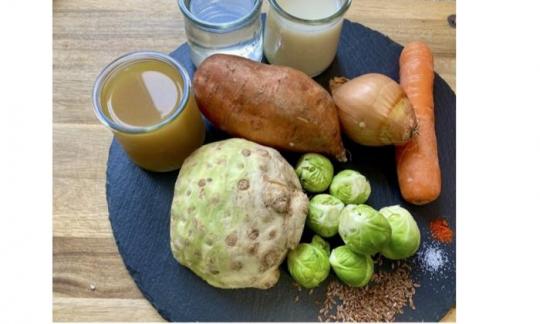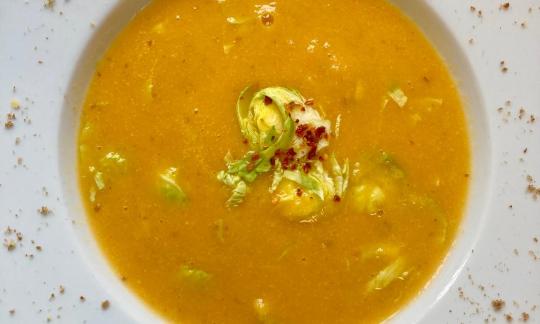Oil-free sweet potato soup with Brussels sprout slices
vegan
Ingredients (for servings, )
| 1 | Onions, raw (organic?) (3.9 oz) |
| 1 | Carrots (carrots), raw (organic?) (2.1 oz) |
| 1 ¾ oz | Celeriac, raw (organic?) |
| 14 oz | Sweet potatoes, raw |
| 5 ½ oz | Brussels sprouts, raw (organic?) |
| 200 ml | Vegan vegetable stock, organic? (7.0 oz) |
| 400 ml | Drinking water, raw (organic?) (14 oz) |
| 1 dash | Table salt (table salt, raw?, organic?) (0.01 oz) |
| ½ tsp | Chili powder (raw?, organic?) (0.05 oz) |
| 200 ml | Oat milk (oat drink, raw?, organic?) (7.0 oz) |
| 4 tsp, ground | Linseed, raw, organic? (golden linseed, flax) (0.35 oz) |
Equipment
- hand-held blender / immersion blender or blender
- vegetable peeler
- stove
- coffee grinder, electric
- saucepan
Type of preparation
- cook
- chop or grind
- sweat
- season to taste
- purée
- deglaze
- remove the skin
- peel
Preparation
Preparing vegetables
Peel the onion and cut into fine cubes. Clean and dice the carrot. Peel and dice the celery and sweet potatoes. Clean the Brussels sprouts and cut into thin slices.Preparation of the soup
Put the diced onion in a coated pan and sauté with 1-2 tablespoons of water. Add the carrot, sweet potato and celery and deglaze with the vegetable stock and tap water. Cook the vegetables for about 8 minutes at a medium temperature. In the meantime, grind the linseed in a coffee grinder.Cook gently: We deliberately cook the vegetables for a very short time in order to retain as high a proportion of the desired nutrients as possible.
Finishing the soup
Puree the soup. Season with salt and chili powder. Add the Brussels sprouts and cook in the hot soup for about 3-5 minutes. Add the ground flaxseed and oat milk and stir. Add a little more water depending on the desired consistency.Make your own oat milk - and alternatives: You can also make your own oat milk. Information on making your own raw vegan oat milk can be found at the following link. As an alternative to oat milk, you can also use water or other plant-based drinks - e.g. based on hazelnuts, almonds, soy or rice. Information on how to make them can be found in the linked ingredients.
Serving size: The recipe is designed as a main course for 2-3 or a starter for 4-5 people.
|
Nutritional Information per person
Convert per 100g
|
2000 kcal | |
|---|---|---|
| Energy | 222 kcal | 11.1% |
| Fat/Lipids | 3.1 g | 4.5% |
| Saturated Fats | 0.39 g | 2.0% |
| Carbohydrates (inc.dietary fiber) | 45 g | 16.8% |
| Sugars | 14 g | 15.1% |
| Fiber | 9.1 g | 36.4% |
| Protein/Albumin | 5.9 g | 11.9% |
| Cooking Salt (Na:236.6 mg) | 601 mg | 25.0% |
| Essential micronutrients with the highest proportions | per person | 2000 kcal | |
|---|---|---|---|
| Vit | Vitamin K | 114 µg | 153.0% |
| Vit | Vitamin A, as RAE | 1'180 µg | 147.0% |
| Vit | Vitamin C (ascorbic acid) | 53 mg | 67.0% |
| Min | Manganese, Mn | 0.95 mg | 48.0% |
| Elem | Potassium, K | 929 mg | 46.0% |
| Vit | Vitamin B6 (pyridoxine) | 0.61 mg | 43.0% |
| Fat | Alpha-Linolenic acid; ALA; 18:3 omega-3 | 0.86 g | 43.0% |
| Min | Copper, Cu | 0.35 mg | 35.0% |
| Prot | Tryptophan (Trp, W) | 0.09 g | 35.0% |
| Vit | Vitamin B9, B11 (Folate, as the active form of folic acid) | 69 µg | 35.0% |
Detailed Nutritional Information per Person for this Recipe
The majority of the nutritional information comes from the USDA (US Department of Agriculture). This means that the information for natural products is often incomplete or only given within broader categories, whereas in most cases products made from these have more complete information displayed.
If we take flaxseed, for example, the important essential amino acid ALA (omega-3) is only included in an overarching category whereas for flaxseed oil ALA is listed specifically. In time, we will be able to change this, but it will require a lot of work. An “i” appears behind ingredients that have been adjusted and an explanation appears when you hover over this symbol.
For Erb Muesli, the original calculations resulted in 48 % of the daily requirement of ALA — but with the correction, we see that the muesli actually covers >100 % of the necessary recommendation for the omega-3 fatty acid ALA. Our goal is to eventually be able to compare the nutritional value of our recipes with those that are used in conventional western lifestyles.
| Essential fatty acids | per person | 2000 kcal |
|---|---|---|
| Alpha-Linolenic acid; ALA; 18:3 omega-3 | 0.86 g | 43.0% |
| Linoleic acid; LA; 18:2 omega-6 | 0.83 g | 8.0% |
| Essential amino acids | per person | 2000 kcal |
|---|---|---|
| Tryptophan (Trp, W) | 0.09 g | 35.0% |
| Threonine (Thr, T, irreversibly transaminated) | 0.27 g | 29.0% |
| Isoleucine (Ile, I) | 0.21 g | 17.0% |
| Valin (Val, V) | 0.28 g | 17.0% |
| Phenylalanine (Phe, F) | 0.25 g | 16.0% |
| Lysine (Lys, K, irreversibly transaminated) | 0.26 g | 14.0% |
| Leucine (Leu, L) | 0.31 g | 13.0% |
| Methionine (Met, M) | 0.08 g | 9.0% |
| Vitamins | per person | 2000 kcal |
|---|---|---|
| Vitamin K | 114 µg | 153.0% |
| Vitamin A, as RAE | 1'180 µg | 147.0% |
| Vitamin C (ascorbic acid) | 53 mg | 67.0% |
| Vitamin B6 (pyridoxine) | 0.61 mg | 43.0% |
| Vitamin B9, B11 (Folate, as the active form of folic acid) | 69 µg | 35.0% |
| Vitamin B1 (Thiamine) | 0.34 mg | 31.0% |
| Vitamin B5 (Pantothenic acid) | 1.5 mg | 26.0% |
| Vitamin E, as a-TEs | 1.7 mg | 14.0% |
| Vitamin B2 (Riboflavin) | 0.18 mg | 13.0% |
| Vitamin B3 (Niacin) | 1.9 mg | 12.0% |
| Vitamin B7 (Biotin, ex vitamin H) | 4.2 µg | 8.0% |
| Essential macroelements (macronutrients) | per person | 2000 kcal |
|---|---|---|
| Potassium, K | 929 mg | 46.0% |
| Sodium, Na | 237 mg | 30.0% |
| Phosphorus, P | 192 mg | 27.0% |
| Magnesium, Mg | 83 mg | 22.0% |
| Calcium, Ca | 118 mg | 15.0% |
| Essential trace elements (micronutrients) | per person | 2000 kcal |
|---|---|---|
| Manganese, Mn | 0.95 mg | 48.0% |
| Copper, Cu | 0.35 mg | 35.0% |
| Iron, Fe | 2.6 mg | 19.0% |
| Zinc, Zn | 1.3 mg | 13.0% |
| Selenium, Se | 3.0 µg | 5.0% |
| Fluorine, F | 130 µg | 4.0% |
| Iod, I (Jod, J) | 3.6 µg | 2.0% |
The oil-free sweet potato soup with celery, carrot and Brussels sprout slices is quick and easy to prepare.
Serving size: The recipe is designed as a main course for 2-3 or a starter for 4-5 people.
Nutrient profile: One portion of this dish covers more than the average daily requirement of vitamins K and A. Vitamin C is covered by over 50% and omega-3 fatty acids by over 40%. The ratio of omega-6 to omega-3 fatty acids is 1:1, which is significantly below the maximum recommended ratio of 5:1. Read more at: Vegans often eat unhealthily. Avoidable nutritional errors.
Sweet potatoes: Sweet potatoes, also called sweet potatoes, are not actually potatoes at all. Although they grow as tubers in the ground, unlike regular potatoes they are not part of the nightshade family. The tubers have a high water content and cannot be stored as long as regular potatoes, but you can increase their shelf life by handling them carefully, such as avoiding bruising. The potato-like tubers come in different colors: orange-red with red-brown skin, yellow with red skin, and white with a light skin. We used the former in this recipe.
Brussels sprouts: Unlike other cabbages, Brussels sprouts do not consist of one head. This typical winter vegetable consists of several whitish-green buds. Brussels sprouts are not only rich in vitamins and nutrients, but are also said to protect white blood cells against cell damage caused by carcinogenic substances. The ingredient sulforaphane, which is also found in broccoli, is still the subject of current studies. The taste of Brussels sprouts is typically cabbage-like and slightly bitter, which is why children often do not like them. However, the bitter taste gives way to a tart-sweet aroma if Brussels sprouts are harvested after the first frost. The optimal harvest time is November/December.
Vegetable stock: A basic distinction is made between broth and stock. Broth serves both as a basic ingredient and as a dish in its own right, whereas stock is a heavily boiled, concentrated, and therefore unfinished cooking ingredient. However, depending on the concentration, stock is a very intense flavor carrier. For health reasons, we deliberately choose the low-salt version (see below).
Flaxseed: Flaxseed has a slightly nutty taste and a fat content of 40%. It contains around 50% of the polyunsaturated omega-3 fatty acid alpha-linolenic acid (ALA), making it the highest concentration of omega-3 fatty acids of all known vegetable oils.
Reduce salt and oil: We have consciously reduced salt and left out oil for health reasons. You can find more information on this topic in the book we describe in detail: "Salt Sugar Fat" by Michael Moss.
Cook gently: We deliberately cook the vegetables for a very short time in order to retain as high a proportion of the desired nutrients as possible.
Make your own oat milk: You can also make your own oat milk. Information on making your own raw vegan oat milk can be found at the following link. As an alternative to oat milk, you can also use water or other plant-based drinks - e.g. based on hazelnuts, almonds, soy or rice. Information on how to make them can be found in the linked ingredients.
Stock: You can buy stock or make it yourself. Stocks are available in every well-stocked supermarket, usually in jars. However, commercial stocks often contain added salt, which is something to keep in mind for further use. If you want to make your own vegetable stock, you will find a suitable recipe below:
- Vegan vegetable stock with celery, leek, fennel
Oil: If you don't want to do without oil completely, you can sauté the onions in 1-2 tablespoons of refined rapeseed oil.








